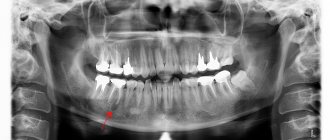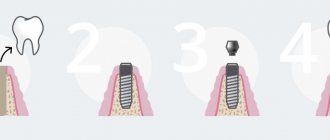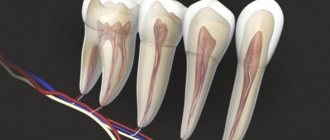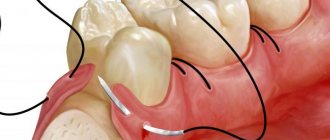In what cases is it removed?
- Rejection . Usually occurs in the first three to six months after implantation. Less often - after a year of use. The reason may be a violation of the surgical protocol during the operation, improper care of the system by the patient, or illness.
- Peri-implantitis and mucositis. The first is an inflammatory process of soft tissues, accompanied by loss of jawbone volume, the second - without loss. Occurs due to wound infection.
- Overloaded titanium structure usually occurs due to improper installation.
- Incorrect placement is rare. Only an inexperienced doctor can make a mistake when installing a system, so when choosing a specialist you need to ask how long he has been practicing and look for reviews about his work.
- Implant defects - this situation is excluded from well-known brands. Each element undergoes multi-stage testing, during which low-quality products are eliminated. Cheap analogues do not undergo as many studies as expensive models, and if a defect is discovered, not every manufacturer will agree to a replacement.
- End of service life - requires removal of the implant. However, proper care can increase the service life.
- The implant is removed if the inflammatory process does not go away within two weeks with active treatment.
If there is a disease that is not associated with tissue inflammation, and the titanium rod has already taken root, then its removal is undesirable. In this case, measures must be taken to treat the existing pathology.
Disadvantages of one-stage implantation
Installing an implant using a one-step protocol may be against installation, as there may be a higher risk of complications. Even after the most gentle removal, the gums and bone are injured, plaque can accumulate in the socket, leading to inflammation and implant rejection. However, if the procedure was carried out in strict accordance with the protocol, such problems are excluded. The risk of complications and recovery time directly depend on the equipment used and the experience of the implantologist. There is no need to take risks by trusting your health to untested doctors.
There are definitely disadvantages to the technique of installing an implant in the socket of an extracted tooth. The procedure is relatively immediate; the patient still needs to visit the clinic several times to undergo diagnostics and prepare for the intervention. The disadvantages also include high requirements for the quality and volume of bone tissue, and a large list of restrictions.
Causes and symptoms of implant rejection
The main indication for titanium root removal is rejection. There may be several reasons for this:
- violation of the integrity of the rod due to mechanical trauma or overload;
- development of peri-implantitis, mucositis, osteoporosis in forms that cannot be treated;
- incorrect installation;
- allergic reaction to the structure;
- serious disruption of the immune system;
- significant increase in blood sugar;
- exacerbation of chronic diseases;
- failure by the patient to follow the doctor’s recommendations in the postoperative period;
- smoking, drug addiction, alcoholism (included in the list of contraindications for implantation);
- neglect of the rules of oral hygiene (dangerous due to the development of inflammatory processes, activation of pathogenic microbes and infection of the jaw structures).
The reason for removing a dental implant may also be a specialist error :
- preliminary sanitation of the oral cavity was carried out poorly;
- no pathologies from the list of contraindications to the procedure were identified;
- the chosen technique did not correspond to the state of the bone structure;
- incorrect selection of implant;
- poor quality titanium construction;
- a refill with an expired expiration date was supplied;
- violation of sterility conditions during surgery, surgical protocol;
- incorrect choice of location for implantation of the system;
- using a faulty surgical instrument.
Implant rejection is accompanied by a number of clinical manifestations that should not be ignored by the patient. Suspicious symptoms should be reported to your doctor immediately.
You should be wary:
- severe pain in the area of the implanted system;
- redness, blueness, swelling of the gums;
- compactions, bumps with purulent contents on the mucous membrane;
- bleeding;
- prolonged bleeding.
Stages of treatment
The duration of one-stage implantation is about 4-6 months. Restoration of bone tissue after tooth extraction is not required; bone tissue augmentation as a separate procedure is also not performed. Therefore, after installing the implants, a temporary prosthesis is immediately fixed, and after a few months, when the implants and bone tissue have completely fused, a permanent dental crown is installed.
Galina Vladimirovna, 57 years old
“I had my natural teeth removed and implants were immediately placed. Within a week my smile was back. I really like the way I look and the way I talk. My diction hasn’t changed, I’m comfortable. I am very pleased and grateful to the doctors!”
- we give SMILES, HEALTH and new LIFE
- smile and enjoy every day
- start CHEWING immediately
- forget about the unpleasant smell and pain
- complete the entire treatment in a WEEK
watch a video with the patient
Preparation for implantation (from 2 days to 2-3 weeks)
When a tooth is removed and an implant is installed at once, sometimes there is very little time left to prepare for treatment, since most often teeth that are in very poor condition have to be removed. However, implantologists pay great attention to this stage, since it is necessary to conduct a thorough examination of the patient’s oral cavity and body, to exclude possible contraindications that could cause rejection of the structure.
Preparation for immediate implantation is absolutely standard and includes taking a series of blood tests, taking an X-ray or panoramic photo of the jaw, as well as dental treatment and removal of deposits. If there are acute problems with the body, we can refer the patient to an appointment with a highly specialized doctor to clarify the diagnosis, assess the state of health and carry out appropriate treatment
Installation of implants and bone grafting (1-2 hours)
Installation of an implant with simultaneous tooth extraction is carried out in a fairly simplified form: additional tissue incisions and bone drilling are not required to form a bed for the implant. The tooth is removed from the socket as carefully as possible, with minimal trauma to the bone tissue. Next, the cavity is thoroughly sanitized. If necessary, an x-ray is prescribed so that you can make sure that the cavity is empty and there are no pieces of instruments or parts of the tooth left inside it. Next, a dental implant is fixed in the hole, and the space around it is sprinkled with artificial bone tissue. The gums around the implant are sutured.
Temporary prosthetics (3-6 months)
Depending on the initial situation, both one-piece and two-piece implants can be used for simultaneous implantation. Both of them can be instantly loaded with a temporary prosthesis.
Three types of structures can be used as temporary dentures (they are selected based on the quality of bone tissue, the degree of primary fixation of the dental implant and the number of missing teeth):
- removable immediate denture (for front and side teeth),
- lightweight plastic crown (only for front teeth with single restorations),
- acrylic prosthesis with plastic crowns (with complete edentia).
A resin crown is created that is slightly shorter in length than the adjacent teeth in the row. This allows you to significantly reduce the load on the prosthesis, and hence the implant itself. At the same time, the appearance of the smile is maintained at the highest level. From the point of view of further aesthetics, a single crown is a more preferable option for single restorations, since it allows you to shape the position of the gums.
It is important! Installation of a single crown is possible only on single-rooted teeth, which do not bear much pressure, and they mostly perform aesthetic functions - these are incisors and canines. If you chew food with the restored tooth, the implant simply will not take root, since it will shift due to the load.
In case of complete edentia, when it is necessary to restore the entire dentition, several implants are installed at once. If there are teeth that need to be removed, some of the implants can be fixed into their sockets. In this case, a fixed prosthesis with a metal base, acrylic base and plastic crowns is fixed on top. It firmly connects all installed implants, which prevents them from moving. Read more about immediate loading methods >>>
Permanent prosthetics (1-2 weeks)
Permanent prosthetics are the final stage of treatment. It can be started only after the doctor is convinced that the implants have completely fused with the bone tissue - measurements are carried out with special devices and x-rays.
The temporary crown is removed, impressions are taken - the data is transferred to a dental laboratory, where an individual prosthesis is created. The dental technician must take into account the position of neighboring and antagonist teeth located on the opposite jaw. The manufacturing process takes about 1-2 weeks.
Metal-ceramics or zirconium can be chosen as materials for permanent dentures - these crowns are more aesthetic, stronger and more durable.
Advantages of the method
- shortened treatment times,
- no bone grafting required
- instant restoration of aesthetics,
- no bone tissue augmentation is carried out,
- lower cost of treatment,
- The service life of installed implants is more than 20 years.
Disadvantages of the method
The only disadvantage of one-step implantation is that it is not always possible to carry out it. You need to prepare for treatment: assess the condition of the body, exclude contraindications, select an implant model depending on the volume and quality of bone tissue. But the removal of your own tooth quite often has to be done urgently, which does not make it possible to conduct a full examination and understand whether it is possible to install an implant at the same time.
Dental implant removal process
Removing an implant is a surgical operation performed under the influence of an anesthetic. It consists of several stages:
- Removing the tooth crown.
- Unscrewing the abutment.
- Removing the rod from the jaw.
- Antibacterial treatment.
- Establishing the causes of rejection to select the correct treatment.
Next, the recovery stage begins, based on the patient’s compliance with the specialist’s prescriptions and proper oral care.
Many people faced with this unpleasant situation are concerned with the question: “How long does it take for the gums to heal after removal of the implant?” This usually takes at least two months . Then re-implantation is possible.
Alternatives
Single or segmental row defects can be eliminated using alternative methods - removable or bridge dentures. However, their use is possible only after complete tissue healing. Removable orthopedic devices do not stop bone atrophy; fixed bridges slow down the process, but do not completely eliminate it. 3-4 months after the operation, the alveolar ridge decreases, gum recession occurs, which is especially noticeable in the incisor area.
The use of removable structures is accompanied by unpleasant sensations as a result of rubbing soft tissues, and also reduces the patient’s quality of life due to restrictions on the use of solid foods.
How to avoid implant removal
Preventing implant removal is not difficult. To do this, you need to follow the doctor’s recommendations and follow simple rules for caring for the oral cavity after surgery:
- do not eat solid food;
- exclude spicy, sour, hot, cold foods, strong coffee from the diet;
- stop smoking (tobacco smoke interferes with the implantation of the structure);
- do not subject the artificial root to increased loads;
- avoid situations that are traumatic for the jaw;
- do not visit the sauna, bathhouse;
- brush your teeth twice a day (in the morning - after breakfast, in the evening - before bed);
- use additional dental care products: irrigator, floss;
- Visit a specialist regularly and undergo examination.
Features of the rehabilitation period
After the operation, the implantologist will give detailed recommendations to the patient regarding care, regimen, and nutrition. Since the implantation was gentle, pain is usually mild or absent. Discomfortable sensations, as after a regular removal, go away on their own within 3-5 days.
Scrupulous adherence to medical instructions in the postoperative period ensures rapid and trouble-free healing and prevents the development of complications. Recommendations are conventionally divided into general and medical.
Clinical cases
Let us give examples from life regarding the unsuccessful completion of osseointegration, which resulted in the removal of the implant.
- After chemotherapy, a man had a titanium structure installed on the area of his jaw that had a malignant formation. The patient did not inform the doctor about the presence of a serious pathology, and the doctor did not notice bone changes in the operated area. Naturally, engraftment did not take place due to a decrease in the regenerative function of the bone. After the removal of the rod, six months passed before reimplantation became possible. During this time, the implantologist and oncologist actively took measures to solve the problem.
- The patient was treated by an orthodontist. She was fitted with braces and offered to have one tooth implanted. Since there was not enough space for it, bone augmentation was performed. After integration of the artificial root, it was rejected due to compression by neighboring teeth, as a result of which it was removed.
Peri-implantitis
Among all the problems that arise after implant installation, peri-implantitis is the most common. It accounts for 12-43% of all cases of complications. The tissue around the implant begins to become inflamed, resulting in bone loss.
Symptoms of peri-implantitis:
- Swelling and tenderness of the soft tissues at the site of the artificial root.
- Bleeding, purulent fistulas on the gums.
- Formation of a gum pocket more than 1 mm deep in the implant area.
- Implant mobility due to bone loss.
Peri-implantitis can be successfully treated if diagnosed in time, and an experienced doctor can save the implant.
When the first signs of inflammation appear, come to the Zuub.rf clinic. Thanks to this, the doctor quickly makes a diagnosis and carries out treatment. This is necessary to save the implant.
Prevention of negative consequences
The specialist must:
- prepare the oral cavity for surgery;
- diagnose diseases included in the list of contraindications;
- perform plastic surgery of the jawbone, if required;
- follow the surgical protocol for the procedure;
- ensure complete sterility;
- issue recommendations for the rehabilitation period.
The patient must:
- inform the doctor about existing serious illnesses;
- undergo the necessary examination;
- carry out assignments;
- ensure quality oral hygiene.
What the patient should know
Every person who is going to undergo a dental implant procedure must have the following information:
- implantation is a commercial service and is not included in the list of “Compulsory health insurance”;
- a denture that is broken for no reason by the patient can be replaced free of charge with a new one only in the clinic where it was placed;
- the cost of treating complications is much higher than the cost of implantation , so it is necessary to strictly adhere to the specialist’s prescriptions.
An important point is the selection of the clinic. Well-established dental centers provide a long-term guarantee on their work and are responsible for its quality.
Lifetime Warranty
We have created all the conditions to exclude medical and technological errors, so without fear we provide a lifetime guarantee for implantation
We work with the best premium implants from the leading company Nobel Biocare®, for which, together with the manufacturer, we provide an indefinite guarantee in the Dr.Levin LifeTime Warranty format . For each installed implant, a passport with a number and series is issued.
Since 2004 we have been the Nobel Biocare® Center of Clinical Excellence in Eastern Europe. This status is available provided that over 10 years of work, the percentage of rejection of implants installed in the clinic is less than 2%.
What determines the service life of a dental implant?
The service life of the implant assumes the warranty specified by the manufacturer on the packaging. Companies that produce premium dental structures, for example, Nobel Biocare, Astra Tech, XIVE Friadent, Straumann, give them a lifetime guarantee . They will not have to be changed unless unforeseen circumstances arise.
Other companies set a period of 20-25 years . After this time, the worn-out implant, if defective, must be removed. Although, with proper care, even such options last longer than the manufacturer indicated.
The service life of titanium roots is affected by:
- qualified work of an implantologist;
- professionalism of the orthopedist in the manufacture of the prosthesis;
- high quality construction;
- proper oral hygiene;
- absence of serious diseases.
The presence of these conditions favors the long-term operation of installed dental systems.
Branded rehabilitation - for quick recovery
A unique complex of accelerated rehabilitation
- Lymphatic drainage. Biostimulants improve lymph outflow, prevent the formation of edema and hematomas, tighten the facial contour
- PRP plasma lifting. Platelet-rich blood plasma heals, stops the appearance of hematomas, and reduces swelling
- Microcurrent therapy. Low frequency currents relieve facial microspasms and pain, improve metabolism and healing
More details
We work exclusively with premium implants from the leading company Nobel Biocare®. The line of implantation systems allows you to select the necessary implant in any clinical situation, including simultaneous implantation after the removal of anterior or chewing teeth. We provide a lifetime warranty for implantation together with the manufacturer.










